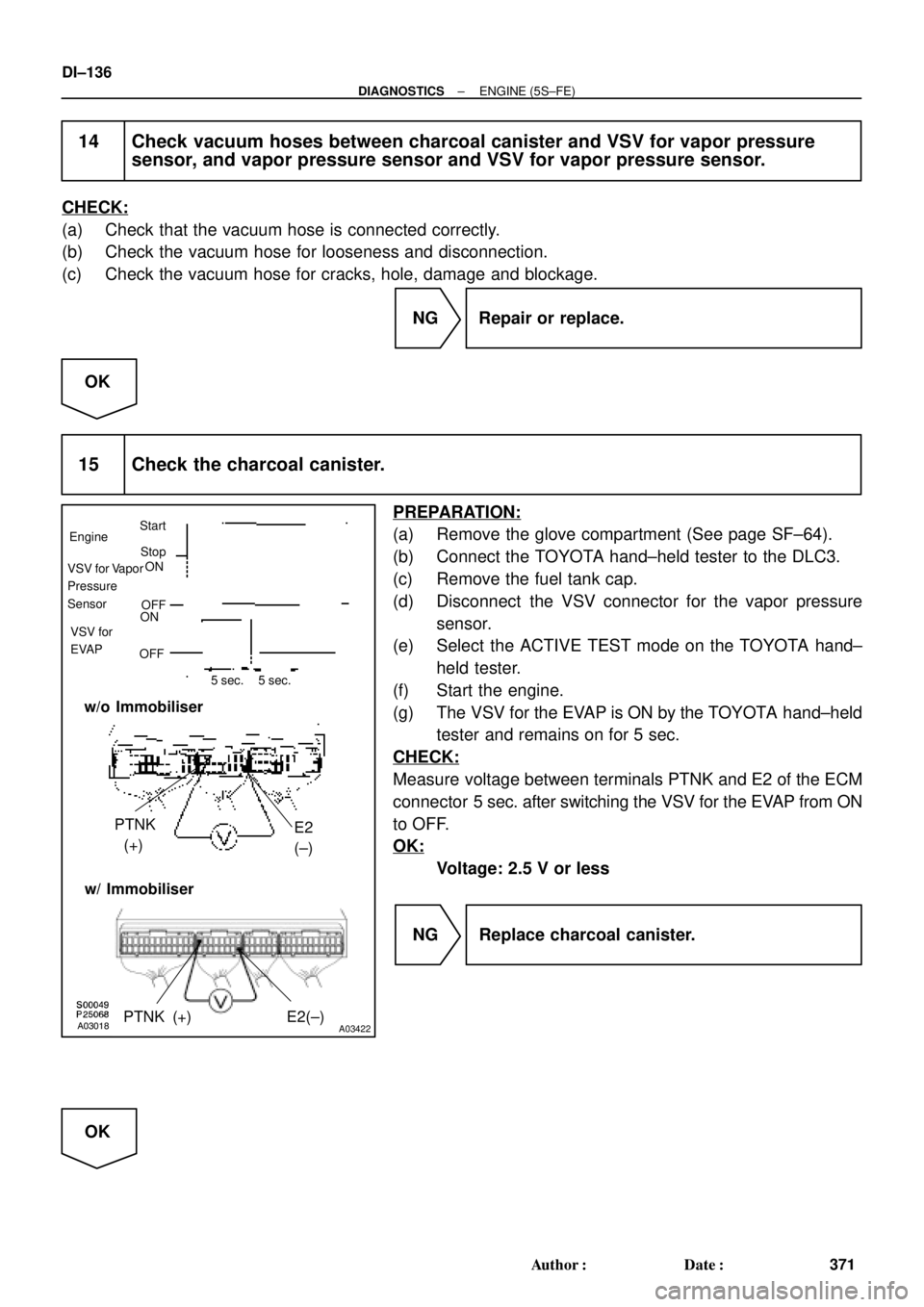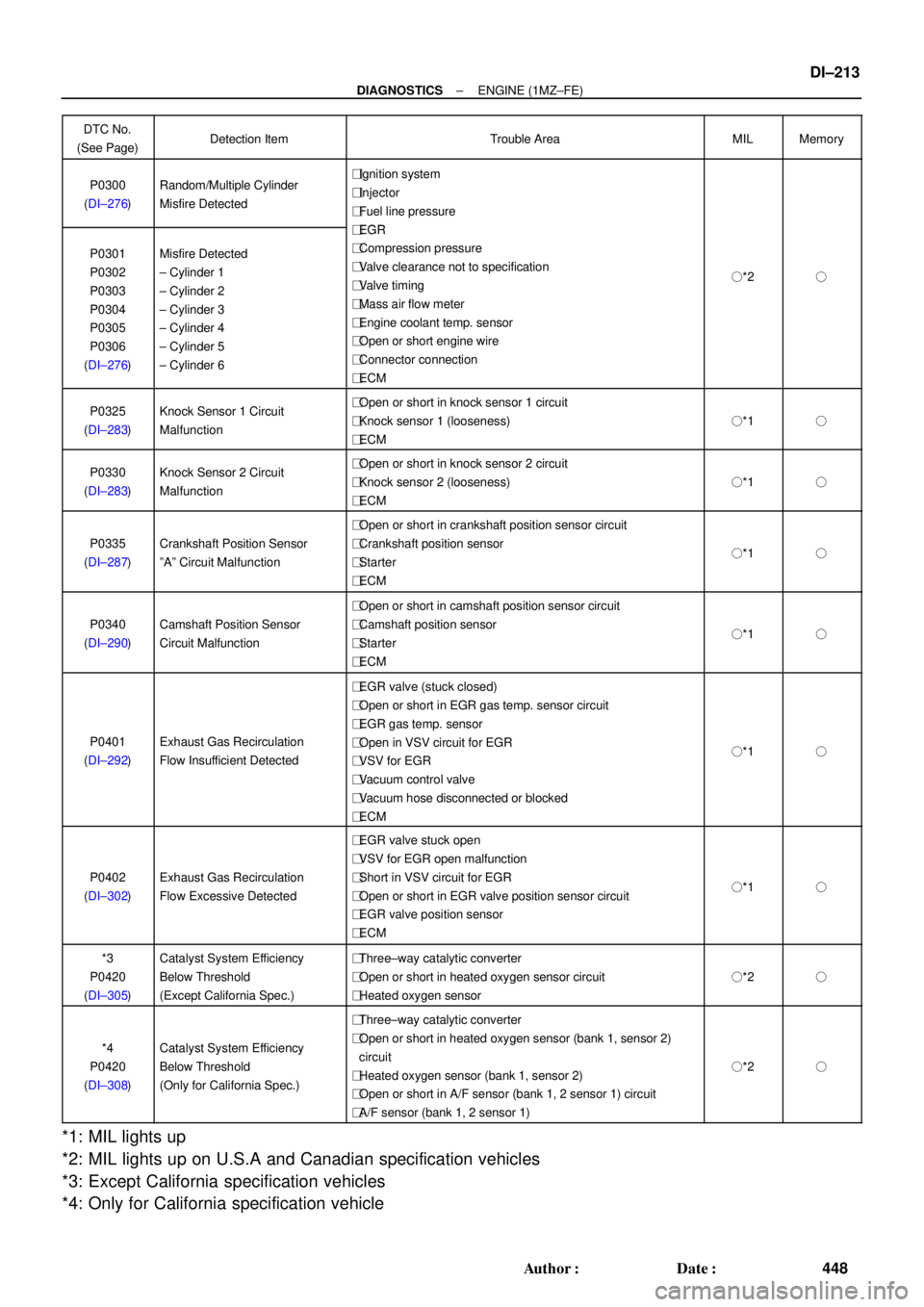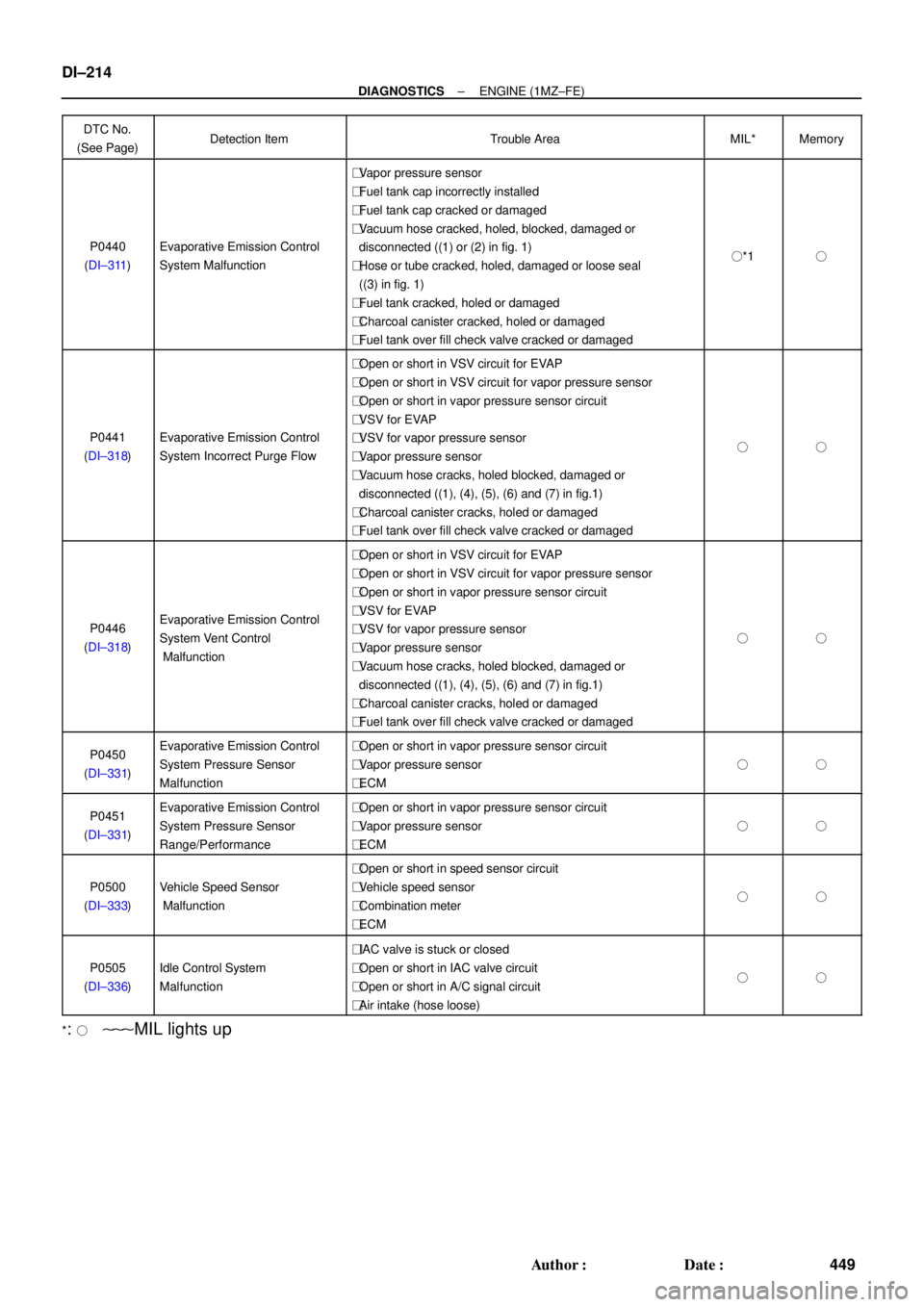Page 2553 of 4770
± DIAGNOSTICSENGINE (5S±FE)
DI±133
368 Author�: Date�:
7 Check vacuum hose between intake manifold and VSV for EVAP, and VSV for
EVAP and charcoal canister.
CHECK:
(a) Check that the vacuum hose is connected correctly.
(b) Check the vacuum hose for looseness and disconnection.
(c) Check the vacuum hose for cracks, hole, damage and blockage.
NG Repair or replace.
OK
8 Check operation of VSV for EVAP (See page SF±45).
OK Go to step 9.
NG
Replace VSV, charcoal canister and then clean the vacuum hose between throttle body and VSV
for EVAP, and VSV for EVAP and charcoal canister.
9 Check for open and short in harness and connector between EFI main relay
(Marking: EFI) and VSV for EVAP, and VSV for EVAP and ECM
(See page IN±31).
NG Repair or replace harness or connector.
OK
Check and replace ECM (See page IN±31).
Page 2554 of 4770
A00472
ON
FE
G
FE
G
VSV is ON
VSV is OFF
DI±134
± DIAGNOSTICSENGINE (5S±FE)
369 Author�: Date�:
10 Check the VSV for vapor pressure sensor.
PREPARATION:
(a) Connect the TOYOTA hand±held tester to the DLC3.
(b) Turn the ignition switch ON and push the OBD II scan tool
or TOYOTA hand±held tester main switch ON.
(c) Select the ACTIVE TEST mode on the TOYOTA hand±
held tester.
CHECK:
Check the VSV operation when it is operated by TOYOTA
hand±held tester.
OK:
(1) VSV is ON:
Air from port E is flowing out through port F.
(2) VSV is OFF:
Air from port E is flowing out through port G.
OK Go to step 13.
NG
11 Check operation of VSV for vapor pressure sensor (See page SF±47).
OK Gp to step 12.
NG
Replace VSV charcoal canister, and then clean the vacuum hoses between charcoal canister and
VSV for vapor pressure sensor, and VSV for vapor pressure sensor and vapor pressure sensor.
Page 2556 of 4770

A03018A03422
ON EngineStart
Stop
VSV for Vapor
Pressure
Sensor
OFFOFF
ON
VSV for
EVAP
5 sec. 5 sec.
PTNK
(+)E2
(±) w/o Immobiliser
w/ Immobiliser
PTNK (+) E2(±)
DI±136
± DIAGNOSTICSENGINE (5S±FE)
371 Author�: Date�:
14 Check vacuum hoses between charcoal canister and VSV for vapor pressure
sensor, and vapor pressure sensor and VSV for vapor pressure sensor.
CHECK:
(a) Check that the vacuum hose is connected correctly.
(b) Check the vacuum hose for looseness and disconnection.
(c) Check the vacuum hose for cracks, hole, damage and blockage.
NG Repair or replace.
OK
15 Check the charcoal canister.
PREPARATION:
(a) Remove the glove compartment (See page SF±64).
(b) Connect the TOYOTA hand±held tester to the DLC3.
(c) Remove the fuel tank cap.
(d) Disconnect the VSV connector for the vapor pressure
sensor.
(e) Select the ACTIVE TEST mode on the TOYOTA hand±
held tester.
(f) Start the engine.
(g) The VSV for the EVAP is ON by the TOYOTA hand±held
tester and remains on for 5 sec.
CHECK:
Measure voltage between terminals PTNK and E2 of the ECM
connector 5 sec. after switching the VSV for the EVAP from ON
to OFF.
OK:
Voltage: 2.5 V or less
NG Replace charcoal canister.
OK
Page 2558 of 4770
DI±138
± DIAGNOSTICSENGINE (5S±FE)
373 Author�: Date�:
2 Check vacuum hoses ((1), (4), (5), (6), (7), (8) and (9) on page DI±122).
CHECK:
(a) Check that the vacuum hose is connected correctly.
(b) Check the vacuum hose for looseness and disconnection.
(c) Check the vacuum hose for cracks, hole, damage and blockage.
NG Repair or replace.
OK
3 Check voltage between terminals VC and E2 of ECM connector
(See page DI±122, step 9).
NG Check and replace ECM (See page IN±31).
OK
4 Check voltage between terminals PTNK and E2 of ECM connector
(See page DI±122, step 10).
OK Go to step 6.
NG
5 Check for open and short in harness and connector between vapor pressure
sensor and ECM (See page IN±31).
NG Repair or replace harness or connector.
OK
Replace vapor pressure sensor.
Page 2559 of 4770
A03019A03423
EVPON
ON
OFF
E
E
F
VSV is ON
VSV is OFF w/o Immobiliser
w/ Immobiliser
ON
OFF
FE EVP
± DIAGNOSTICSENGINE (5S±FE)
DI±139
374 Author�: Date�:
6 Check VSV for EVAP.
PREPARATION:
(a) Remove the glove compartment (See page SF±64).
(b) Turn the ignition switch ON.
CHECK:
Check VSV function.
(1) Connect between terminal EVP of the ECM con-
nector and body ground (ON).
(2) Disconnect between terminal EVP of the ECM con-
nector and body ground (OFF).
OK:
(1) VSV is ON:
Air from port E is flowing out through port F.
(2) VSV is OFF:
Air does not flow from port E to port F.
OK Go to step 8.
NG
7 Check operator of VSV for EVAP (See page SF±45).
NG Go to step 9.
OK
Replace VSV and clean vacuum hoses between throttle body and VSV for EVAP, and VSV for
EVAP and charcoal canister, and then check charcoal canister.
Page 2561 of 4770
± DIAGNOSTICSENGINE (5S±FE)
DI±141
376 Author�: Date�:
10 Check operation of VSV for vapor pressure sensor (See page SF±47).
NG Go to step 11.
OK
Replace VSV and clean vacuum hoses between charcoal canister and VSV for vapor pressure
sensor, and VSV for vapor pressure sensor and vapor pressure sensor, and then check the char-
coal canister.
11 Check for open and short in harness and connector between EFI main relay
(Marking: EFI) and VSV for vapor pressure sensor, and VSV for vapor pressure
sensor and ECM (See page IN±31).
NG Repair or replace harness or connector.
OK
Check and replace ECM (See page IN±31).
12 Check fuel tank over fill check valve (See page EC±6).
NG Replace fuel tank over fill check valve or fuel
tank.
OK
Check and replace charcoal canister
(See page EC±6).
Page 2633 of 4770

± DIAGNOSTICSENGINE (1MZ±FE)
DI±213
448 Author�: Date�:
DTC No.
(See Page)Detection ItemTrouble AreaMILMemory
P0300
(DI±276)Random/Multiple Cylinder
Misfire Detected�Ignition system
�Injector
�Fuel line pressure
EGR
P0301
P0302
P0303
P0304
P0305
P0306
(DI±276)Misfire Detected
± Cylinder 1
± Cylinder 2
± Cylinder 3
± Cylinder 4
± Cylinder 5
± Cylinder 6
�EGR
�Compression pressure
�Valve clearance not to specification
�Valve timing
�Mass air flow meter
�Engine coolant temp. sensor
�Open or short engine wire
�Connector connection
�ECM
�*2�
P0325
(DI±283)Knock Sensor 1 Circuit
Malfunction�Open or short in knock sensor 1 circuit
�Knock sensor 1 (looseness)
�ECM
�*1�
P0330
(DI±283)Knock Sensor 2 Circuit
Malfunction�Open or short in knock sensor 2 circuit
�Knock sensor 2 (looseness)
�ECM
�*1�
P0335
(DI±287)Crankshaft Position Sensor
ºAº Circuit Malfunction
�Open or short in crankshaft position sensor circuit
�Crankshaft position sensor
�Starter
�ECM
�*1�
P0340
(DI±290)Camshaft Position Sensor
Circuit Malfunction
�Open or short in camshaft position sensor circuit
�Camshaft position sensor
�Starter
�ECM
�*1�
P0401
(DI±292)Exhaust Gas Recirculation
Flow Insufficient Detected
�EGR valve (stuck closed)
�Open or short in EGR gas temp. sensor circuit
�EGR gas temp. sensor
�Open in VSV circuit for EGR
�VSV for EGR
�Vacuum control valve
�Vacuum hose disconnected or blocked
�ECM
�*1�
P0402
(DI±302)Exhaust Gas Recirculation
Flow Excessive Detected
�EGR valve stuck open
�VSV for EGR open malfunction
�Short in VSV circuit for EGR
�Open or short in EGR valve position sensor circuit
�EGR valve position sensor
�ECM
�*1�
*3
P0420
(DI±305)Catalyst System Efficiency
Below Threshold
(Except California Spec.)�Three±way catalytic converter
�Open or short in heated oxygen sensor circuit
�Heated oxygen sensor
�*2�
*4
P0420
(DI±308)Catalyst System Efficiency
Below Threshold
(Only for California Spec.)
�Three±way catalytic converter
�Open or short in heated oxygen sensor (bank 1, sensor 2)
circuit
�Heated oxygen sensor (bank 1, sensor 2)
�Open or short in A/F sensor (bank 1, 2 sensor 1) circuit
�A/F sensor (bank 1, 2 sensor 1)
�*2�
*1: MIL lights up
*2: MIL lights up on U.S.A and Canadian specification vehicles
*3: Except California specification vehicles
*4: Only for California specification vehicle
Page 2634 of 4770

DI±214
± DIAGNOSTICSENGINE (1MZ±FE)
449 Author�: Date�:
DTC No.
(See Page)Detection ItemTrouble AreaMIL*Memory
P0440
(DI±311)Evaporative Emission Control
System Malfunction
�Vapor pressure sensor
�Fuel tank cap incorrectly installed
�Fuel tank cap cracked or damaged
�Vacuum hose cracked, holed, blocked, damaged or
disconnected ((1) or (2) in fig. 1)
�Hose or tube cracked, holed, damaged or loose seal
((3) in fig. 1)
�Fuel tank cracked, holed or damaged
�Charcoal canister cracked, holed or damaged
�Fuel tank over fill check valve cracked or damaged
�*1�
P0441
(DI±318)Evaporative Emission Control
System Incorrect Purge Flow
�Open or short in VSV circuit for EVAP
�Open or short in VSV circuit for vapor pressure sensor
�Open or short in vapor pressure sensor circuit
�VSV for EVAP
�VSV for vapor pressure sensor
�Vapor pressure sensor
�Vacuum hose cracks, holed blocked, damaged or
disconnected ((1), (4), (5), (6) and (7) in fig.1)
�Charcoal canister cracks, holed or damaged
�Fuel tank over fill check valve cracked or damaged
��
P0446
(DI±318)Evaporative Emission Control
System Vent Control
Malfunction
�Open or short in VSV circuit for EVAP
�Open or short in VSV circuit for vapor pressure sensor
�Open or short in vapor pressure sensor circuit
�VSV for EVAP
�VSV for vapor pressure sensor
�Vapor pressure sensor
�Vacuum hose cracks, holed blocked, damaged or
disconnected ((1), (4), (5), (6) and (7) in fig.1)
�Charcoal canister cracks, holed or damaged
�Fuel tank over fill check valve cracked or damaged
��
P0450
(DI±331)Evaporative Emission Control
System Pressure Sensor
Malfunction�Open or short in vapor pressure sensor circuit
�Vapor pressure sensor
�ECM
��
P0451
(DI±331)Evaporative Emission Control
System Pressure Sensor
Range/Performance�Open or short in vapor pressure sensor circuit
�Vapor pressure sensor
�ECM
��
P0500
(DI±333)Vehicle Speed Sensor
Malfunction
�Open or short in speed sensor circuit
�Vehicle speed sensor
�Combination meter
�ECM
��
P0505
(DI±336)Idle Control System
Malfunction
�IAC valve is stuck or closed
�Open or short in IAC valve circuit
�Open or short in A/C signal circuit
�Air intake (hose loose)
��
*: ����� MIL lights up